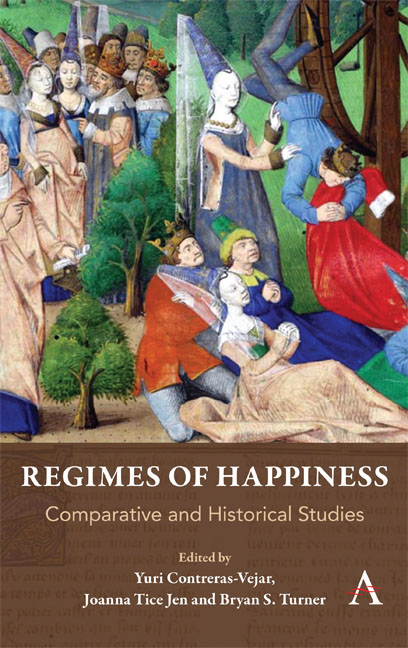Book contents
- Frontmatter
- Contents
- Acknowledgements
- Notes on Contributors
- Introduction: Reflections on Regimes of Happiness
- Part I Happiness in the West
- Chapter One A Fragment of Bliss: Augustinian Beatitudo and the Ideal of Atonement
- Chapter Two Arts of Happiness and Love: Translating Aristotle in the Later Middle Ages
- Chapter Three Spiritual Transcendence as the Path to Happiness in a Selection of Old French Texts
- Chapter Four On Machiavelli, St. Francis and the Pursuit of Happiness
- Chapter Five Their Idea of Happiness Prevents Easy Categorization of Scottish Enlightenment Philosophers
- Chapter Six A Path to Eternal Happiness: Convent Life in the United States in the Nineteenth Century
- Chapter Seven “Be Joyful Always!”: Twenty-First-Century Evangelical Conceptions of Happiness and Trumpist Politics
- Chapter Eight The Erasmus Program: The Promise of European Happiness
- Chapter Nine Innovations in the Psychological Study of Happiness: From Mirror Neurons to Mobile Technology
- Part II Comparative Perspectives
- Index
Chapter Six - A Path to Eternal Happiness: Convent Life in the United States in the Nineteenth Century
from Part I - Happiness in the West
Published online by Cambridge University Press: 29 May 2019
- Frontmatter
- Contents
- Acknowledgements
- Notes on Contributors
- Introduction: Reflections on Regimes of Happiness
- Part I Happiness in the West
- Chapter One A Fragment of Bliss: Augustinian Beatitudo and the Ideal of Atonement
- Chapter Two Arts of Happiness and Love: Translating Aristotle in the Later Middle Ages
- Chapter Three Spiritual Transcendence as the Path to Happiness in a Selection of Old French Texts
- Chapter Four On Machiavelli, St. Francis and the Pursuit of Happiness
- Chapter Five Their Idea of Happiness Prevents Easy Categorization of Scottish Enlightenment Philosophers
- Chapter Six A Path to Eternal Happiness: Convent Life in the United States in the Nineteenth Century
- Chapter Seven “Be Joyful Always!”: Twenty-First-Century Evangelical Conceptions of Happiness and Trumpist Politics
- Chapter Eight The Erasmus Program: The Promise of European Happiness
- Chapter Nine Innovations in the Psychological Study of Happiness: From Mirror Neurons to Mobile Technology
- Part II Comparative Perspectives
- Index
Summary
After a long absence from the narrative of American Catholic history, more recently we have learned quite a bit about the collective history of women religious in the United States in the nineteenth century, and the stories that have emerged indicate that the life was enormously popular (McCauley 2014; Ronan 2004). Offering an alternative life for women in the Western world for centuries, the convent as a life choice has experienced swells in popularity over time (McNamara 1996; Rapley 2011). Such was the case in the United States in the nineteenth century when there was enormous growth in the number of both sisterhoods and sisters. Unlike contemplative groups maintaining little contact with the outside world, with very few exceptions these sisterhoods would be very much engaged on behalf of and among others. The earliest foundation in what would become the United States began in French Louisiana in 1727; the first on Unites States soil (a contemplative group) was founded in Maryland in 1790. Several other groups were founded in the next decades but not all continued beyond the initial effort. However, by 1840 there was clearly a movement afoot and after 1850 permanent growth was steady. New groups founded after midcentury included communities initiated by Americanborn women but many were organized by sisters sent from European convents, in particular from France, Germany and Ireland. Estimates place the number of women living the religious life in the United States in 1900 to be approximately 46,500 (McGuinness 2013, 17–52; Stewart 1984, 562–65; Sullivan 1940, 11–95).
The popularity of the convent throughout the nineteenth century offers an excellent example of how economic and social change influenced individual actions taken in pursuit of happiness and that regimes of happiness do not take place in a vacuum. The tumultuous circumstances in the United States in that era offered a multitude of opportunities for sisters to pursue fulfillment, in a particular (but not exclusive) model of religious life that combined both prayer and service, often outside their convent. In this world their goal was a closer relationship with God; ultimate fulfillment would come with eternal happiness in the next world.
- Type
- Chapter
- Information
- Regimes of HappinessComparative and Historical Studies, pp. 79 - 92Publisher: Anthem PressPrint publication year: 2019



